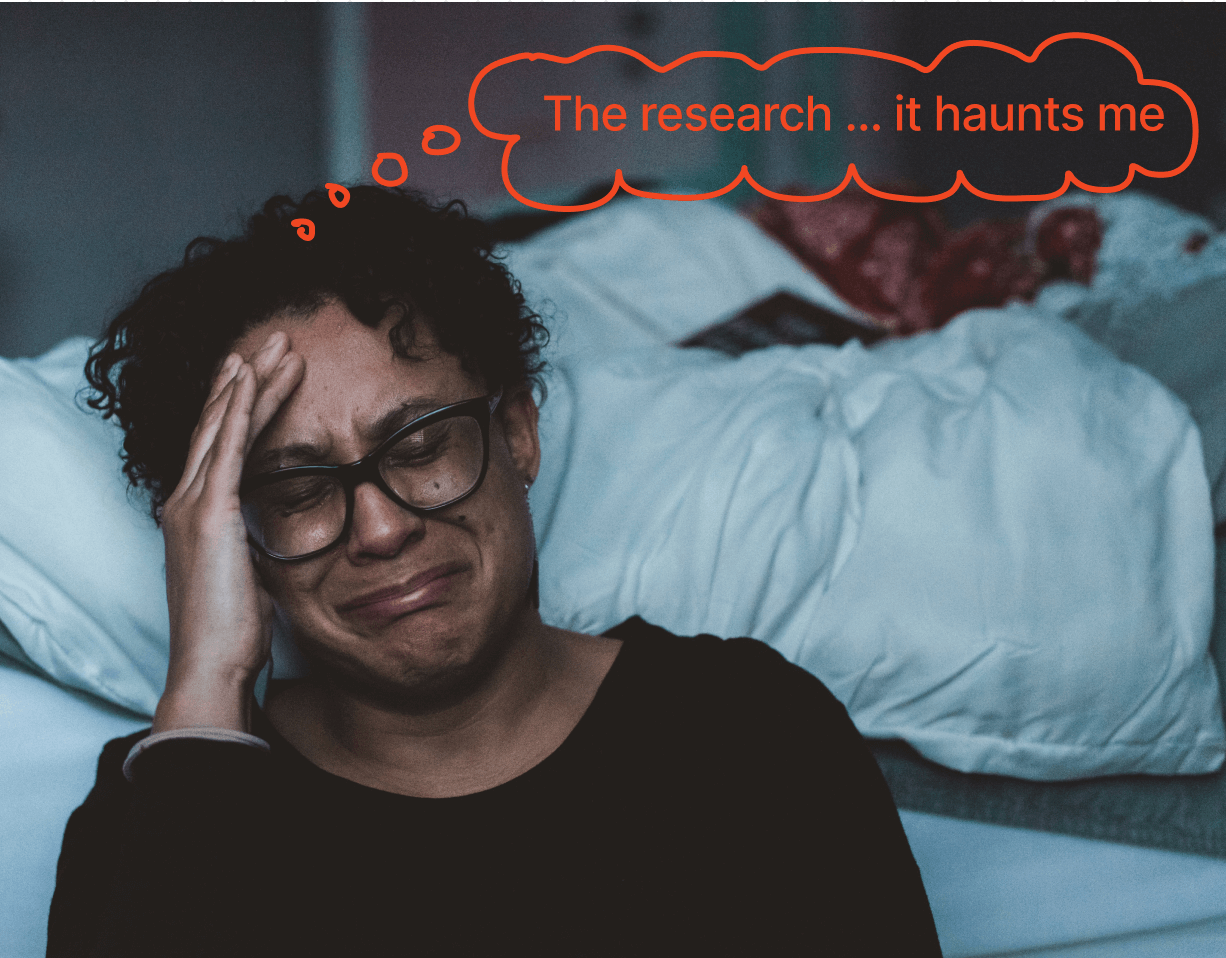To write effective copy, you need research.
But how much research should you do?
Is there such a thing as “too much research”?
Are there clear signs that you’ve done enough research?
How do you know when to stop researching and to start writing?
If you’ve ever asked questions like these, you’re not alone.
Research is one of those things that can feel difficult to pin down, especially if you’re new to copywriting.
So today I’m going to answer these commonly asked questions – and give you a few tips to keep you from going “research crazy.”

But first, when I say “research” what am I talking about exactly?
Every marketer uses different types of research, but most website copywriters – myself included – use specific types of research to get ideas that will help shape things like content strategy and copy.
The most common types of research methodologies used by copywriters are:
✓ Discovery Questionnaire (internal research)
At the beginning of every project I send a questionnaire to all of my clients to collect a baseline of information about the brand, product/service, customers, competitors, and more.
✓ Interviews (internal & external research)
This includes both stakeholder interviews (meaning interviewing the client and/or internal team) and customer interviews (speaking 1-on-1 with actual customers or those who represent the ideal target audience).
✓ Surveys (external research)
This could include all types of surveys, but for this article, I’m talking about surveys that are delivered via email or SMS and are focused on very specific types of questions.
✓ Review mining (external research)
This includes reading through my clients’ customer reviews in search of insights or Voice of Customer Data. I may also look through the reviews of their competitors, which can also yield interesting insights.
There are other types of research I conduct for my clients (including competitive audits, site audits, user tests, market research, and more), but if you’re only writing copy, you can usually get what you need from the methodologies I mentioned above.
When copywriting, how much research should I do?
This varies depending on the project.
Some projects are massive and need a lot of time and research, while others are small and only need a little bit of research.
It will also depend on the resources and research insights available.
Sometimes you can only get 3 customers to agree to an interview, or get 20 responses in a survey. You have to work with what you can get.
Either way, it can be helpful to have some benchmarks or baselines you should aim for when conducting research.
Here’s what I aim for when conducting research for my copywriting projects:
✓ Interviews
I typically aim for 6-8 customer interviews and at least 1 stakeholder interview.
Sometimes I’ll do fewer (if it’s a smaller project with fewer customers) and sometimes I’ll do more (but usually no more than 10).
If you have multiple audiences (i.e. 2-3 for example) you might need to take that into consideration (for example, you might need to do 3-4 interviews for each audience type).
✓ Surveys
I typically aim for at least 100 survey responses.
In an ideal world, hundreds or thousands of responses is best (so you can feel more confident in the trends you’re seeing) – but I’m not analyzing thousands of responses manually.
I use AI tools (like Bard from Google) to help me identify recurring themes in larger sets of data so I can see the bigger picture without sacrificing time or sanity.
✓ Review mining
I always aim to read through at least 100 reviews, but if I have time, I’ll usually read through 300-500.
While that sounds like a lot, remember this:
Most reviews are short so you can breeze through the majority of them and stop when you find longer, more detailed reviews that will give you the insights and VOC data you’re looking for.
Reading through hundreds of reviews is also a great way to familiarize yourself with the customers, including how they communicate, what’s important to them, and more.
You can also use AI tools in the same way I mentioned above to identify recurring themes without having to read through every review manually.
🚨 NOTE! 🚨 You don’t need to use every research methodology for every project. Sometimes you only need a few interviews OR just a single survey. Sometimes JUST review mining. Use your judgment to determine which is right for your client/situation.
Is there such a thing as “too much research”?
Yes.
Most copywriters are curious people who genuinely enjoy learning which is why it’s so easy to get lost in the research and forget that you only have so many hours for each project.
Many of us are also perfectionists who worry that if we don’t do enough research, we’ll miss something crucial and the project will fail as a result (not true, btw).
And unlike others, many copywriters ENJOY the process of absorbing tons of information and organizing it in clear and coherent ways.
The problem is, research takes TIME — not just to find the information, but to sift through, analyze, and organize it in a way that makes sense to you AND the client.
The more information there is, the more difficult it becomes to communicate it clearly. With so many details, seeing the bigger picture becomes more and more difficult — and you may end up feeling more confused than clear.
You may also end up using all of your time on research vs writing the actual copy, which will not produce a good outcome for you or the client.
This is why it’s so important to use those benchmarks I mentioned above – and to make sure you allot specific amounts of time during the scoping process for research so you know when you’re under or over hours.
Are there signs that you’ve done enough research? How do you know when to stop researching and to start writing?
Yes, but it takes time and practice.
After working as a copywriter for 10+ years, I have a very specific process I follow to make sure I’m collecting the information I need.
As I collect information, I put it into a document I refer to as an “Insights Report” – when the document is complete, so is the research.
If I finish the Insights Report and I still have questions or need more info, I simply go back to the client or conduct more research to fill that specific gap.
You can get my Insights Report template from my customer research course, but you can also create your own!
All you have to do is think about the information YOU need to write effective copy.
For example, maybe you need demographic information. Or perhaps you need information on goals and pain points. Maybe you need to understand the product more (features, benefits, use cases, etc).
Whatever it is, put those categories into a document, do the research, and then put your findings back into the document under the right categories.
When the document is finished, you should have a better sense of whether or not you need to conduct more research – and if you’re ready to move on to the copywriting phase.
This gets easier with time and practice.
Eventually, you’ll feel so confident in your research abilities that you will simply KNOW when you’ve done enough research and you’ll feel EXCITED to move onto the copywriting phase.
Are you a research junkie?
Awesome!
Keep being you – curiosity and a willingness to learn is a wonderful trait. It makes you a more interesting person and usually a more effective copywriter.
Just keep an eye on the clock and you’ll be fine 😉
As always, thank you for reading! If you enjoyed this article, please share with a friend or colleague.
